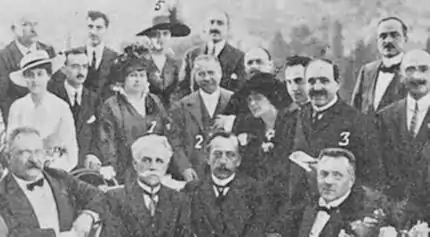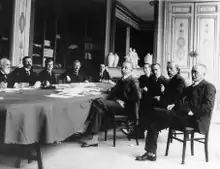Jules Destrée
Jules Destrée (French: [dɛstʁe];[1] Marcinelle, 21 August 1863 – Brussels, 3 January 1936) was a Walloon lawyer, cultural critic and socialist politician. The trials subsequent to the strikes of 1886 determined his commitment within the Belgian Labour Party. He wrote a Letter to the King in 1912, which is seen as the founding declaration of the Walloon movement. He is famous for his quote "Il n'y a pas de Belges" (There are no Belgians), pointing to the lack of patriotic feelings in Flemings and Walloons, while pleading for some kind of federal state.
.jpg.webp)
Biography
His father was an engineer in the chemical industry in Marcinelle and Couillet and later became a professor. Jules himself was a gifted student, getting his PhD in Law from the Université Libre de Bruxelles at the age of 20. His younger brother, Olivier Georges, became a monk, first in the Maredsous Abbey, later in the Keizersberg Abbey in Leuven, under the name Bruno Destrée.
Besides his judicial work, he liked circulating among the artistic and literary circles of his time. There, he met etcher Auguste Danse, whose daughter Marie, a niece of Constantin Meunier, he married in 1889.
In 1892, together with Paul Pastur, he founded the Democratic Federation. He started a political career with the socialist party Parti Ouvrier Belge (POB), and was elected as a member of the Belgian Chamber of People's Representatives in 1894, where he continued to work until his death.
He wrote many and diverse publications; prose, political and social works, and studies on artists (like Odilon Redon and Rogier van der Weyden).
In 1911, during an exhibition of ancient arts of the Hainaut, Jules Destrée realised that Wallonia had many specific characteristics. From then on, he expressed his revendications for an autonomous Wallonia. In November, he gave a talk in front of the association of the young lawyers of Brussels (Jeune Barreau de Bruxelles). During this conference, he proteded the political minorisation of the Walloon people, saying, "We are defeated ones and defeated ones governed against our mentality.[2]
Jules Destrée wrote his opened letter in 1912 to the King of the Belgians Albert I. The letter was published in the Revue de Belgique (15 August 1912) and in the Journal de Charleroi (24 August 1912). The largest newspapers, including la Gazette de Charleroi, l'Express and la Meuse, published the letter later on. And, in the foreign countries, for instance The New York Times published a short article about this letter.[3]

After Germany invaded Belgium in 1914, Jules Destrée went into exile in France at the request of the Belgian government, pleading for the Belgian cause in London, Paris and Rome. He also went on diplomatic missions, to Saint Petersburg and to China in 1918.
From 1919 to 1921 he was Minister of Arts and Sciences. He installed a "Fonds des mieux doués", a fund for the education of gifted children from poor families. In 1920 he started the "Académie de Langue et de Littérature françaises de Belgique", the Academy of French Language and Literature of Belgium.

Until his death, he would continue to work on improving the political situation of Wallonia. In 1923 he left, the "Assemblée wallonne" (the Wallonian Assembly), which he co-founded in 1912, because it had not paid enough attention the Walloon working class. In 1929, he signed, together with Camille Huysmans, the "Compromis des Belges" (Compromise of the Belgians). This document judged separatism, accepted the cultural autonomy of Flanders and Wallonia, and suggested a greater autonomy for municipalities and provinces. It foresaw a bilingual Flanders and a unilingual Wallonia (this was before Brabant was split and the Brussels-Capital Region was created as a separate entity).
Because of his engagement in the League of Nations' Committee on Intellectual Cooperation (between 1022 and 1932),[4] Destrée was appointed head of the International Office of Museums (IOM), a unit of the International Institute of Intellectual Cooperation (IIIC), with Euripide Foundoukidis as secretary.[5] In 1938, the Institut Jules Destrée was founded to promote the regional development of Wallonia. With his heritage, a museum was founded in the attic of the Town Hall of Charleroi (Musée Jules Destrée), which opened in 1988.
Thoughts
According to Destrée, Belgium was composed of two separate entities, Flanders and Wallonia, and a feeling of Belgian nationalism was not possible, illustrated in his 1906 work "Une idée qui meurt: la patrie" (An idea that is dying: the fatherland). In the "Revue de Belgique" of 15 August 1912 he articulates this in his famous and notorious "Lettre au roi sur la séparation de la Wallonie et de la Flandre" (Letter to the king on the separation of Wallonia and Flanders), where he wrote:
Il y a en Belgique des Wallons et des Flamands. Il n'y a pas de Belges.
In Belgium there are Walloons and Flemings. There are no Belgians.
The King agreed secretly with the Destrée's view but not to his proposal of a kind of Home Rule and wrote to his counsellor: I read the letter of Destrée, which, without uncertainty, is some literature of great talent. All that he said is absolutely true, but it is not less true that administrative separation would be an evil with more disadvantages and dangers than any aspect of the current situation.[6] Contrary to what the title of his lettre might suggest, he didn't plead for the separation of Belgium, but for some kind of federal state before such a term even existed.
Une Belgique faite de l'union de deux peuples indépendants et libres, accordés précisément à cause de cette indépendance réciproque, ne serait-elle pas un État infiniment plus robuste qu'une Belgique dont la moitié se croirait opprimée par l'autre moitié?
A Belgium made of the union of two independent and free peoples, made precisely because of this reciprocal independence, would not that be an infinitely more robust State than a Belgium in which one half would consider itself oppressed by the other half?
His primary reason was the fear that Flanders, being more closely populated, would dominate a unitary Belgium.[7] Later, Gaston Eyskens modified his quote, saying "Sire, il n'y a plus de Belges" (Sire, there are no more Belgians), after the first steps were taken to transform Belgian into a federal state.
See also
- Institut Jules-Destrée
References
- Delforge, Paul. "La lettre au Roi de Jules Destrée". YouTube. Institut Destrée. Retrieved 26 November 2018.
- « Nous sommes des vaincus et des vaincus gouvernés contre notre mentalité. »
- "Belgium may separate" (PDF). New York Times. 1912-08-09. Retrieved 2008-06-11.
- Grandjean, Martin (2018). Les réseaux de la coopération intellectuelle. La Société des Nations comme actrice des échanges scientifiques et culturels dans l'entre-deux-guerres [The Networks of Intellectual Cooperation. The League of Nations as an Actor of the Scientific and Cultural Exchanges in the Inter-War Period] (in French). Lausanne: Université de Lausanne.
- McClellan, Andrew (2008-01-02), The Art Museum from Boullée to Bilbao, Univ of California Press, p. 284, ISBN 978-0-520-25126-7, retrieved 2018-05-15
- (in French) J'ai lu la lettre de Destrée qui, sans conteste, est un littérateur de grand talent. Tout ce qu'il dit est absolument vrai, mais il est non moins vrai que la séparation administrative serait un mal entraînant plus d'inconvénients et de dangers de tout genre que la situation actuelle. Landro, 30 août, A Jules Ingebleek, secrétaire privé du Roi et de la Reine, lettre reproduite in extenso in M-R Thielemans et E. Vandewoude, Le Roi Albert au travers de ses lettres inédites, Office international de librairie, Bruxelles, 1982, pp. 435-436.
- see above for instance the note 2
- The Jules Destrée Museum, Retrieved October 13, 2006.
External links
| Wikimedia Commons has media related to Jules Destrée. |
